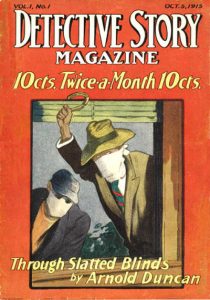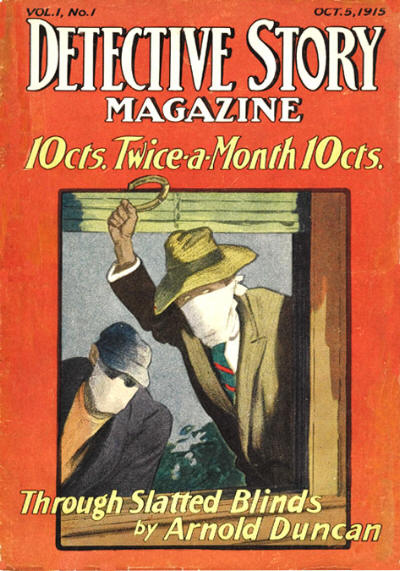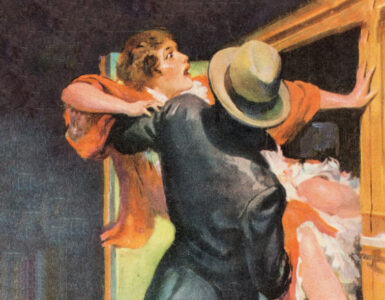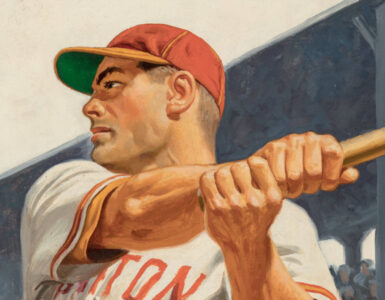 Although it’s not as widely collected as its successors — magazines such as BLACK MASK and DIME DETECTIVE — Street & Smith’s DETECTIVE STORY MAGAZINE was a trailblazer. Its debut issue, dated October 5, 1915, was the first pulp magazine successfully dedicated to one fiction genre. Its first editor, Frank E. Blackwell, explained in an early issue, “I feel that stories dealing with the detection of crime are of more interest to the reading public than any others.” Many more specialty pulps would follow in the ensuing years, culminating in single-character magazines such as THE SHADOW or DOC SAVAGE MAGAZINE.
Although it’s not as widely collected as its successors — magazines such as BLACK MASK and DIME DETECTIVE — Street & Smith’s DETECTIVE STORY MAGAZINE was a trailblazer. Its debut issue, dated October 5, 1915, was the first pulp magazine successfully dedicated to one fiction genre. Its first editor, Frank E. Blackwell, explained in an early issue, “I feel that stories dealing with the detection of crime are of more interest to the reading public than any others.” Many more specialty pulps would follow in the ensuing years, culminating in single-character magazines such as THE SHADOW or DOC SAVAGE MAGAZINE.
DETECTIVE STORY MAGAZINE was a continuation of the nickel weekly, NICK CARTER STORIES, in which the first part of the lead story of the new pulp — “The Yellow Label” — had appeared. According to dime novel and story paper expert, J. Randolph Cox, “The intent was to transfer the reading public of Nick Carter’s adventures over to a more adult and sophisticated fiction magazine.” Judging from its long life — DETECTIVE STORY would run for thirty-four years, from October 5, 1915 through the Summer of 1949, a total of 1,057 issues — Street & Smith’s intent was very ably achieved.
Unlike its highly prized successors — particularly BLACK MASK, the magazine where the hard-boiled detective story first took shape — DETECTIVE STORY emphasized the more traditional or “clued” detective story. Carolyn Wells, Ernest M. Poate, Arthur B. Reeve, Agatha Christie, Dorothy L. Sayers, Ellery Queen, and others all wrote stories along the traditional line, while Edgar Wallace, J. S. Fletcher, Johnston McCulley, Christopher Booth, Herman Landon, and more offered tales of rogue or “bent” heroes. Sax Rohmer was also a contributor to the magazine, introducing the “yellow peril” theme to the magazine’s mix. In later years, the fiction took on a more realistic tone, resembling the stories found in ELLERY QUEEN’S MYSTERY MAGAZINE, the mystery digest that had debuted during the second half of 1941.
Although DETECTIVE STORY MAGAZINE did little to further the development of the detective or crime story, its success would lead to a proliferation of pulp magazines devoted to a single theme or genre. According to the late pulp and science-fiction scholar Sam Moskowitz, “While not the first of the specialized fiction magazines, being preceded by THE OCEAN and THE RAILROAD MAN’S MAGAZINE, it accomplished what they had not by creating a trend that would result in the proliferation of the pulps into western, love, air, science fiction, and supernatural, as well as detective.” Likewise in 1931, the CBS radio series inspired by the magazine’s fiction, DETECTIVE STORY HOUR, would introduce the public to The Shadow, the announcer for each episode. Soon thereafter, Street & Smith would launch THE SHADOW DETECTIVE MAGAZINE, and the single-character pulp would be born.
In 2016, PulpFest intends to salute one-hundred years of the specialty pulp, first popularized during the fall of 1915, when DETECTIVE STORY MAGAZINE premiered. Join us at the Hyatt Regency Columbus from July 21 – 24, 2016. It should be a very special convention!
The first issue of DETECTIVE STORY MAGAZINE featured front cover art by John A. Coughlin, a Chicago-born artist who got his start in his home town’s advertising business. Coughlin moved to New York City in 1912 and painted his first pulp cover a year later — for Street & Smith’s THE POPULAR MAGAZINE. Other pulp clients included ARGOSY, DETECTIVE FICTION WEEKLY, SHORT STORIES, TOP-NOTCH, and WILD WEST WEEKLY. He also contributed cover art for HARPER’S WEEKLY, FARM AND FIRESIDE MAGAZINE, and THE SATURDAY EVENING POST. According to pulp art scholar David Saunders, Coughlin’s cover for the March 7, 1931 issue of DETECTIVE STORY MAGAZINE marks the first painted appearance of The Shadow on a pulp magazine.







